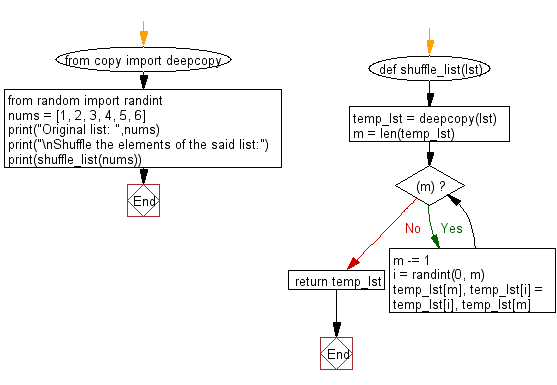Python: Randomize the order of the values of an list
Shuffle List Randomly
Write a Python program to randomize the order of the values of a list, returning a new list.
- Uses the Fisher-Yates algorithm to reorder the elements of the list.
- random.shuffle provides similar functionality to this snippet.
From Wikipedia,
The Fisher–Yates shuffle is an algorithm for generating a random permutation of a finite sequence—in plain terms, the algorithm shuffles the sequence. The algorithm effectively puts all the elements into a hat; it continually determines the next element by randomly drawing an element from the hat until no elements remain. The algorithm produces an unbiased permutation: every permutation is equally likely. The modern version of the algorithm is efficient: it takes time proportional to the number of items being shuffled and shuffles them in place.
Sample Solution:
Python Code:
# Import necessary modules.
from copy import deepcopy
from random import randint
# Define a function called 'shuffle_list' that takes a list 'lst' as an argument.
def shuffle_list(lst):
# Create a deep copy of the input list to avoid modifying the original list.
temp_lst = deepcopy(lst)
# Get the length of the copied list.
m = len(temp_lst)
# Perform Fisher-Yates shuffle by iterating over the list and swapping elements randomly.
while (m):
m -= 1
i = randint(0, m)
temp_lst[m], temp_lst[i] = temp_lst[i], temp_lst[m]
# Return the shuffled list.
return temp_lst
# Example usage: Shuffle the elements of the list 'nums'.
nums = [1, 2, 3, 4, 5, 6]
print("Original list: ", nums)
print("\nShuffle the elements of the said list:")
print(shuffle_list(nums))
Sample Output:
Original list: [1, 2, 3, 4, 5, 6] Shuffle the elements of the said list: [3, 2, 4, 1, 6, 5]
Flowchart:

For more Practice: Solve these Related Problems:
- Write a Python program to shuffle a list randomly without using the built-in random.shuffle method.
- Write a Python program to shuffle a list randomly while keeping the first and last elements fixed.
- Write a Python program to randomly shuffle a list and then verify that no element remains in its original index.
- Write a Python program to implement a custom shuffle algorithm that produces reproducible results using a given seed.
Go to:
Previous: Write a Python program to map the values of a list to a dictionary using a function, where the key-value pairs consist of the original value as the key and the result of the function as the value.
Next: Write a Python program to get the difference between two given lists, after applying the provided function to each list element of both.
Python Code Editor:
What is the difficulty level of this exercise?
Test your Programming skills with w3resource's quiz.
